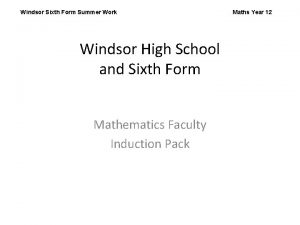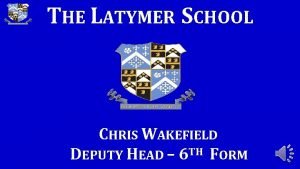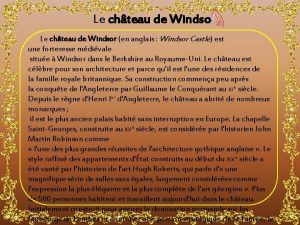Windsor Sixth Form Summer Work Windsor High School



















- Slides: 19

Windsor Sixth Form Summer Work Windsor High School and Sixth Form Mathematics Faculty Induction Pack Maths Year 12

Getting Started… Congratulations on completing your GCSE studies, you are now ready to begin the next stage of your education. It is important that you get some rest over the summer to re-energise, but it is also important that you spend time preparing for the A Level Mathematics course. This induction pack contains worked examples and practice exercises for you to complete prior to beginning your studies in September. All of the content contained within this induction pack is Higher GCSE content. It is essential that you have a thorough understanding of these topics and can confidently perform all of these skills with fluency. This will enable you to make the best possible start to the A Level Mathematics course. It is recommended that you spend at least one hour a week working through this induction pack over the summer. You will complete an assessment during your first week of lessons in order to assess your understanding of these vital skills. If you have taken the time to complete this induction pack to a good standard, you should feel confident in making a positive start to your studies. We look forward to welcoming you in September. Mr Wootton

Contents 1. 2. 3. 4. 5. 6. 7. 8. Factorising Indices Surds Solving Quadratics Completing the Square Simultaneous Equations of Straight Lines Algebraic Fractions

Factorising is the reverse of expanding brackets. You will need to know how to factorise completely a wide range of expressions, but we will focus specifically on quadratic expressions here. The same two numbers must multiply to give this value Two numbers add to give this value 1 and -6 are the only two numbers that work here The last terms in each bracket must multiply to give -10 The first terms in each bracket must multiply to give 6 x 2 This expands to give 6 x 2 – 11 x – 10 as we require Try out combinations that satisfy these two conditions, such as 3 x and 2 x, -5 and 2, put them in double brackets, then expand to check your answer is correct

Factorising Exercise Part A Part B

Indices The laws of indices allow you to simplify powers of the same base. Here we will focus on exponents that are fractional and/or negative. Using the second rule, x to the power of 6 over 3 is x 2 The cube root of 125 is 5 Using the second rule, the square root of 25 is 5, which is then cubed to become 125 Using the third rule, a negative power means put 1 over the same base to the positive power

Indices Exercise Part A Part B

Surds are irrational numbers which are written as the square root of a non-square integer. You need to recall how to manipulate these, including rationalising the denominator where necessary. Expand single bracket as normal Manipulate using the first rule This is the second rule from the list below Expand top and bottom Simplify the denominator

Surds Exercise Part A Part B

Solving Quadratics Quadratic equations can be solved using a variety of techniques. Some can be factorised into two brackets first, but those which can’t be factorised may be solved by using the formula. Equation must be made equal to zero first Subtract 2 and 3 x from both sides The left factorises here Solve each bracket equal to zero Only one solution here as 4 is a repeated root

Solving Quadratics Exercise Part A Part B

Completing the Square This technique enables us to determine the turning point of a quadratic graph, in order to find its maximum or minimum value. It can also be used to solve quadratics, but this section will limit itself to the former case only. Apply the rule Simplify this part Take the factor of 3 out first, then apply the rule to the bracket This is a single bracket with 3 outside so expand it by multiplying (x + 1)2 by 3 and 12 by 3 Complete the square for x 2 + 2 x p = 3, q = 1, r = -2

Completing the Square Exercise Part A Part B

Simultaneous Equations The solution to two simultaneous equations is found where their two graphs intersect. This can be performed algebraically for a range of functions, however we will restrict this to two linear, or a linear and a quadratic. Rearrange the easier equation to make x or y the subject, then substitute it into the other equation (here we will make y the subject) We replace y in the second equation with 2 x - 1 Always substitute the linear equation into the quadratic, rearrange if necessary Here we replace all terms of x in the second equation with 3 – 2 y Factorise and solve to find all y values Substitute this x value into the equation for y to find the value of y

Simultaneous Equations Exercise Part A Part B

Equations of Straight Lines The equation of a straight line graph in the Cartesian plane can be used for a variety of purposes, such as mathematical modelling where appropriate. Here we will focus on the calculation of the gradient and intercept. HINT: draw a sketch to help Use the formula to calculate the gradient Find the gradient first by using the formula y = mx + c Substitute one of the coordinates into this equation Find c

Equations of Straight Lines Exercise Part A Part B

Algebraic Fractions and their use are widespread throughout mathematics. Algebraic fractions and their manipulation are a requirement in many calculations, and you will be expected to be proficient in simplifying them. Start by factorising the numerator and denominator where possible Expand brackets in the numerator Subtract the numerators Simplify You must find a common denominator first

Algebraic Fractions Exercise Part A Part B
 Sixth form windsor
Sixth form windsor Brighouse high school open evening
Brighouse high school open evening Shenfield high school sixth form
Shenfield high school sixth form Walton high sixth form application
Walton high sixth form application Mill hill county high school sixth form
Mill hill county high school sixth form Mmodation
Mmodation The sixth sick sheik's sixth sheep's sick lyrics
The sixth sick sheik's sixth sheep's sick lyrics Crescenta valley high school graduation 2021
Crescenta valley high school graduation 2021 Assignment in spanish
Assignment in spanish Walton high sixth form application
Walton high sixth form application Walton high sixth form
Walton high sixth form Walton high sixth form
Walton high sixth form Windsor mountain summer camp
Windsor mountain summer camp Pschee
Pschee The charter school sixth form
The charter school sixth form Ivc summer classes for high school students
Ivc summer classes for high school students Lodi unified summer school
Lodi unified summer school Nuast school holidays
Nuast school holidays Latymer sixth form
Latymer sixth form Crossley heath term dates
Crossley heath term dates


































